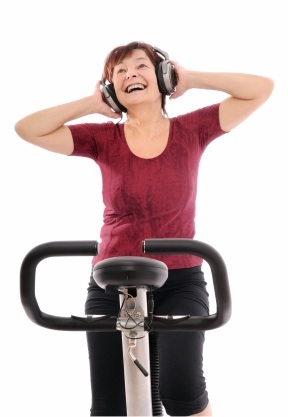We’ve all been there. You’re on a run or in the middle of a workout, starting to feel a lag in energy when all of a sudden the perfect song blasts through your headphones.
“Yes, THAT’S my jam!!” I think, and suddenly I pump my legs faster and find a second wind out of nowhere.
For me that’s “Diamonds” by Rihanna. Maybe for you it’s Survivor’s “Eye of the Tiger” or David Guetta and Sia’s “Titanium. Whatever that song is, I can bet that you’re out there raising the volume on your iPods and moving a bit faster when that tune comes on.

Music works like a magical cure-all when you’re exercising. It has the ability to distract you enough from the strain of what you’re doing, allowing you to focus your attention elsewhere while your body does the work. This is essential for me since I tend to over-analyze pretty much everything at all hours of the day.
Music can motivate you with the right lyrics and tone. Why do you think the theme song to Chariots of Fire is often used in exercise montages?
And the right tempo can truly elevate you reach new heights of endurance and speed where you’re inspired to try harder as you go against the music beat for beat.
How does that work?
The research on this subject is broad and diverse. In a recent study by Dr. Costas Karageorghis of Brunel University in London, a leading expert in the psychology of exercise music, he compared music to “a type of legal performance-enhancing drug.”
Ferris Jabr of Scientific American recently reviewed the research behind the relationship between music and exercise performance. Jabr notes that there are several important qualities to music, including tempo and rhythm response, which play a significant role in how the brain processes the sound and relays the information to our muscles.
To make some broad generalizations, fast songs with strong beats are particularly stimulating, so they fill most people’s workout playlists. In a recent survey of 184 college students, for example, the most popular types of exercise music were hip-hop (27.7 percent), rock (24 percent) and pop (20.3 percent). Some psychologists have suggested that people have an innate preference for rhythms at a frequency of two hertz, which is equivalent to 120 beats per minute (bpm), or two beats per second. When asked to tap their fingers or walk, many people unconsciously settle into a rhythm of 120 bpm. And an analysis of more than 74,000 popular songs produced between 1960 and 1990 found that 120 bpm was the most prevalent pulse.
Synchronicity between the beat of the music and the pace of a workout doesn’t necessarily enhance performance nor is it a preference for most people, but it may help the body use energy more efficiently.
Dr. Carl Foster of the University of Wisconsin, argues our innate tendency to move in time with music goes back to rowers of ancient Rome who coordinated their rowing with the beat of drums. Foster says it’s our brain’s natural response that makes us “want to step at the rate the music is playing or… pedal a cycle at the rate of the dominant beat of the music.”
A study published in the Journal of Sports Medicine and Physical Fitness last year, revealed that cyclists who timed their pedaling with the same tempo as their music, reduced their oxygen uptake by 7%.
Perhaps the most compelling argument for music’s impact on exercise performance is the positive psychological affect various songs have on the ability to improve a workout.
Queuing up a playlist with the scientifically proven ratio of bpm to movement isn’t always the best course of action. A big piece of the formula here is the emotional tie a person may have to a particular song or series of songs that can do more to help increase motivation and self-efficacy.
As Jabr states,
Selecting the most effective workout music is not as simple as queuing up a series of fast, high-energy songs. One should also consider the memories, emotions and associations that different songs evoke. For some people, the extent to which they identify with the singer’s emotional state and viewpoint determines how motivated they feel. And, in some cases, the rhythms of the underlying melody may not be as important as the cadence of the lyrics.
Earlier I mentioned that “Diamonds” from Rihanna was a particular favorite of mine. Clocking in at 92 bpm, this song doesn’t hit that sweet spot of tempo and rhythm. But for some reason, when I hear this song come on during a run, I feel uplifted and the urge to keep moving. I’ve caught on to this reaction and now strategically place this song towards the middle or end of my runs because I know it will give me the push I need to continue through the end of the song, instead of stopping altogether.
So why does this song do that for me? “Diamonds” was released in the weeks before Hurricane Sandy hit the east coast last Fall. The week I spent without power or heat at home, was filled with the sounds coming from our battery-operated radio. As a new single, the song was on repeatedly and became a sort of anthem that I took on personally. The impact of that week was far-reaching and music played a big part of that emotional journey, especially since conserving battery power made those music-filled moments so precious.
When that song plays, I’m brought back to that moment in time and that’s a powerful experience in and of itself. It’s a bittersweet memory that serves as both a source of comfort and inspiration for me now.
I imagine each of us has that same relationship with any number of songs and that you find yourself walking or moving differently as an expression of the intensity of emotion that a song may inspire in that moment. It’s just natural.
The science backs up what I’ve already thought to be true, and that is the positive benefits of music to get our bodies moving and improve well-being. Music has been a part of culture and society throughout human history and it’s an integral part of who we are.
The incredible number of apps and devices available on the market that highlight tailored workout music and calculating performance is astronomical. Researchers and marketers alike are aware of the power of music and its role in exercise.

We’re instinctively attuned to the power of beats and rhythm. Have you ever been able to resist moving in even the slightest way when an irresistible song plays? Nope? Yeah, me either.
Do you listen to music when you exercise? What’s your favorite genre of music? How does it make you feel?
As always, keep paying it forward. Stay healthy! 🙂
Cited Sources:

I’ve heard about this kind of research and it makes perfect sense, given how my body reacts to certain songs while I’m running. So glad you shared this research with your blog community!
LikeLike
Thanks Ilene! I find the way we react to music, whether we’re exercising or studying, to be so fascinating.
LikeLike